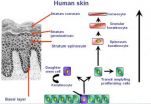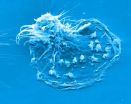(Press-News.org) These mechanisms, described in vivo in mice, engage molecule CD98hc, which is involved in epidermis renewal and could be an indicator of the skin's capacity for regeneration.
The results were published in the Journal of Experimental Medicine review.
The epidermis, the surface layer of the skin, is mainly composed of keratinocytes cells, which, in humans, are renewed continuously over a 21-day cycle. These cells are located on a membrane made up of components from the extracellular matrix that provides the junction with the dermis, the deep layer of the skin (see diagram). The epidermis is renewed by cell proliferation and differentiation that maintains the balance of adult tissues. This balance, known as "homeostasis", is essential for tissues to function correctly and any alterations to it are responsible for the physical changes associated with aging: sagging skin due to reduced skin cell proliferation, wound healing defects, loss of hair, etc.
The ATIP-Avenir team "Epidermal homeostasis and tumorigenesis" directed by Inserm researcher Chloé Féral, studied the numerous cellular factors involved in maintaining this balance. Particular attention was paid to CD98hc, a molecule known for its interaction with receptors that cause skin aging. With age, the activity of the transporter CD98hc and integrins (the receptors connected to the components in the extra cellular matrix) is disturbed. However, until now the mechanisms involved had never been identified.
Through their work, the researchers showed in vivo in mice that removing the gene CD98hc (coding gene for transporter CD98hc) disturbs skin balance and the healing process. By modifying cell proliferation and migration, removing this gene also causes a fault in the hair follicle cycle. The researchers have deciphered all the complex mechanisms associated with CD98hc, particularly integrin deregulation caused by this missing molecule in vivo. They confirm what was described in vitro: the amino acid transporter CD98hc modules the integrin signal, which is essential for skin renewal. As such, CD98hc actively participates in skin renewal through the efficient and widespread recruitment of skin cells when needed (healing a wound, for example).
"CD98hc appears to be necessary for rapid and effective skin renewal. Its reduced expression, observed in vivo in elderly mice, confirms its role in maintaining tissues, the hair follicle cycle and healing, which are disturbed with age," states Chloé Féral. "The status of carrier CD98hc in vivo could be an indicator of the skin's capacity to renew itself" she concludes.
INFORMATION:
Sources
CD98hc (SLC3A2) Regulation of Skin Homeostasis Wanes With Age
Etienne Boulter*, Soline Estrach*, Aurélia Errante, Catherine Pons, Laurence Cailleteau, Floriane Tissot, Guerrino Meneguzzi and Chloé C. Féral
Institute for Research on Cancer and Aging, Nice (IRCAN), AVENIR Team, University of Nice Sophia-Antipolis, INSERM U1081, CNRS UMR 7284, Centre Antoine Lacassagne, Nice, France. Journal of Experimental Medicine, 14 Janvier 2013, 210:173-190.
doi: 10.1084/jem.20121651
Contact chercheur
Chloé Féral
chloe.feral@inserm.fr
The skin aging regulator
2013-01-22
ELSE PRESS RELEASES FROM THIS DATE:
Harmful effects of bisphenol A proved experimentally
2013-01-22
Bisphenol A (BPA) is a chemical compound that is included in the composition of plastics and resins. It is used, for example, in the manufacture of food containers such as bottles and babies' feeding bottles. It is also found in the protective films used inside food and drink cans and on till receipts where it used as a discloser. Significant levels of BPA have also been found in human blood, urine, amniotic fluid and placentas. Recent studies have shown that this industrial component has harmful effects on reproductive ability, development and the metabolism of laboratory ...
Analysis of fracking wastewater yields some surprises
2013-01-22
DURHAM, N.C. -- Hydraulically fractured natural gas wells are producing less wastewater per unit of gas recovered than conventional wells would. But the scale of fracking operations in the Marcellus shale region is so vast that the wastewater it produces threatens to overwhelm the region's wastewater disposal capacity, according to new analysis by researchers at Duke and Kent State universities.
Hydraulically fractured natural gas wells in the Marcellus shale region of Pennsylvania produce only about 35 percent as much wastewater per unit of gas recovered as conventional ...
EARTH: The dangers of solar storms
2013-01-22
Alexandria, VA – Throughout history, humanity has steadily increased its dependence upon technology. Although technology has vastly improved the quality of life for billions of people, it has also opened us up to new risks and vulnerabilities. Terrorism and natural disasters might be at the forefront of the minds of policymakers and the U.S. population, but a significant threat lurks over our heads: the sun. A massive solar storm, the size last seen a century and a half ago, could easily leave hundreds of millions of people in the dark for days, weeks or even months.
The ...
Unprecedented glacier melting in the Andes blamed on climate change
2013-01-22
Glaciers in the tropical Andes have been retreating at increasing rate since the 1970s, scientists write in the most comprehensive review to date of Andean glacier observations. The researchers blame the melting on rising temperatures as the region has warmed about 0.7°C over the past 50 years (1950-1994). This unprecedented retreat could affect water supply to Andean populations in the near future. These conclusions are published today in The Cryosphere, an Open Access journal of the European Geosciences Union (EGU).
The international team of scientists – uniting researchers ...
How can evolutionary biology explain why we get cancer?
2013-01-22
Over 500 billion cells in our bodies will be replaced daily, yet natural selection has enabled us to develop defenses against the cellular mutations which could cause cancer. It is this relationship between evolution and the body's fight against cancer which is explored in a new special issue of the Open Access journal Evolutionary Applications.
"Cancer is far from a single well-defined disease which we can identify and eradicate," said Dr Athena Aktipis, Director, Human and Social Evolution, Center for Evolution and Cancer at the University of California, San Francisco. ...
Children with egg allergies can safely receive flu vaccine, U-M study says
2013-01-22
Ann Arbor, Mich. — Egg allergic children, including those with a history of anaphylaxis to egg, can safely receive a single dose of the seasonal influenza vaccine, according to a new study from the University of Michigan.
Historically, the CDC recommended that the seasonal influenza vaccine not be administered to egg allergic children. Recent research conducted at the University of Michigan, and elsewhere, helped modify this recommendation in 2011 so that caution was warranted for only those with severe egg allergy.
The new study, published in the Annals of Allergy, ...
Hypertension during pregnancy increases risk of end-stage renal disease
2013-01-22
Women with hypertensive disorders in pregnancy are at higher risk of chronic kidney disease and end-stage renal disease compared with women without the disorders, according to a study in CMAJ (Canadian Medical Association Journal).
"We found that women with hypertensive disorders during pregnancy were at higher risk of end-stage renal disease than women without complicated pregnancies," writes Dr. I-Kuan Wang, Division of Nephrology, China Medical University Hospital, Taichung, Taiwan, with coauthors.
Hypertensive disorders such as gestational hypertension and preeclampsia ...
Antibacterial agent used in common soaps found in increasing amounts in freshwater lakes
2013-01-22
When people wash their hands with antibacterial soap, most don't think about where the chemicals contained in that soap end up. University of Minnesota engineering researchers do.
A new University of Minnesota study determined that the common antibacterial agent, called triclosan, used in soaps and many other products is found in increasing amounts in several Minnesota freshwater lakes. The findings are directly linked to increased triclosan use over the past few decades.
In addition, the researchers found an increasing amount of other chemical compounds, called chlorinated ...
Paradise found for Latin America's largest land mammal
2013-01-22
NEW YORK (January 22, 2012) —Wildlife Conservation Society scientists have documented a thriving population of lowland tapirs – the strange forest and grassland-dwelling herbivore with the trunk-like snout – living in a network of remote national parks spanning the Peru-Bolivia border.
Using a combination of camera traps, along with interviews with park guards and subsistence hunters, WCS estimates at least 14,500 lowland tapirs in the region. The population bridges five connected national parks in northwest Bolivia and southeastern Peru.
The WCS findings were described ...
Immune system molecule with hidden talents
2013-01-22
This press release is available in German.
Dendritic cells, or DCs for short, perform a vital role for the immune system: They engulf pathogens, break them down into their component parts, and then display the pieces on their surface. This in turn signals other immune cells capable of recognizing these pieces to help kick-start their own default program for fighting off the invaders. In order to do their job, the DCs are dependent upon the support from a class of immune system molecules, which have never before been associated with dendritic cells: antibodies, best ...



